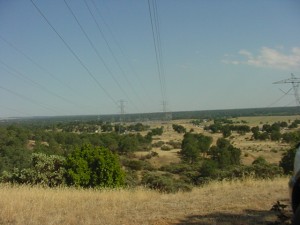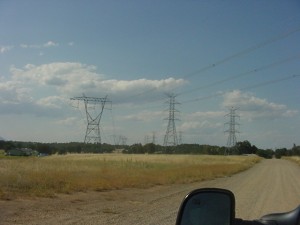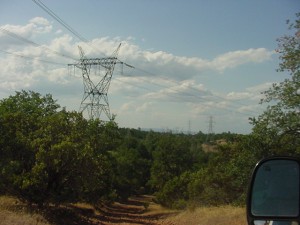TANC Board said ENOUGH! DONE!
July 16th, 2009
Yes, more good news. Yesterday, the TANC Board met, and were heard on the public conference call to vote, one by one, to put an end to this project that no one wants:
Special Op-ed: TANC’s Implosion: Lessons of Failure
And that marked the demise of what many critics called, “The Power Line to Nowhere.”
From “Silicon Valley Mercury News” (ummm, whatever happend to San Jose Mercury News?):
Controversial power line project canceled
Posted: 07/15/2009 07:00:00 PM PDT
Updated: 07/15/2009 09:05:35 PM PDT
On Monday, the Modesto and Turlock Irrigation Districts followed suit.
Greetings from California and the TANC line
July 8th, 2009
Working on tanking the TANC line — proposed by TANC, WAPA, et al — unbelievable what they’re trying to do here. The short version is at StopTANC and on this map:
More later, in the meantime, here are some photos from the scene of the crime:
We had a hoot yesterday, bouncing around in the mountains on 4 wheel trails looking at transmission, chauffered by a “fellow” truckdriver, and in the jump seat, another transmission fighter with a German Shepherd Dog! Yes, we are having fun.
TANC transmission line “gasping”
July 3rd, 2009
The NYRI line in New York was turned down, PJM has eliminated the Indian River, DE to Salem, NJ segment of MAPP, and TANC is imploding before us! YEAAAAA!
This week, SMUD pulled out of TANC. What does that mean? It means SMUD is paying attention to demand and financing, YEAAAAA, and it means that over 1/3 of the project’s $$$ is MIA, YEAAAA!!!!
From the Modesto Bee:
Power project gasping for cash
Partners don’t see survival without a $525M transfusion
By Ed Fletcher
efletcher@sacbee.com
The Western Area Power Authority is a federal partner.
On Thursday, those partners grappled with questions about the project’s vitality.
PSE&G’s PR machine
July 2nd, 2009
Here’s their PR machine:
Here’s the poop:
New Poll Finds Strong Public Support for PSE&G’s Transmission Line UpgradeJul 1, 2009 12:38 AM
Public Service Enterprise Group Inc.A recent poll finds that the majority of people in Morris and Sussex counties in New Jersey favors PSE&G’s plan to upgrade the Susquehanna-Roseland transmission line to ensure reliability of the electric grid.
The poll, conducted by the firm of Luntz, Maslansky Strategic Research, showed approximately 3-to-1 support for the project, with 60 percent of those surveyed saying they “strongly support” or “somewhat support” it, compared to 22 percent who “strongly oppose” or “somewhat oppose” the line. Support for the line was equally strong regardless of the respondent’s proximity to the line.
“It is evident that most people understand that the existing line, which went into service in 1931, can’t be expected to handle today’s demand for safe, reliable electric service without an upgrade,” said Ralph LaRossa, president and COO of PSE&G.
“If we don’t act, Morris and Sussex counties, as well as all of northern New Jersey, could experience widespread brownouts and blackouts by the summer of 2012,” LaRossa said. “That’s not our judgment at PSE&G. It’s the verdict of the independent experts empowered by the federal government to manage the electrical grid. It’s a warning we take very seriously.”
The poll showed that 81 percent of the people in these counties see America’s energy situation as either a “crisis” or “major problem.” LaRossa added, “Most people who live in this area clearly understand the need to do what is required to maintain and ensure reliability.”
PSE&G, which funded the poll, is seeking permission to invest $750 million on the upgrade, adding a 500-kilovolt line to the existing 230-kilovolt line, within an existing transmission right-of-way. The project would create the equivalent of nearly 4,000 jobs lasting one year each, according to a recent report by senior economists at Rutgers University. And by relieving some of the congestion that drives up electric rates in New Jersey, it would help contain electricity costs for homes and businesses in the region.
The Board of Public Utilities is considering PSE&G’s petition to upgrade the line and is expected to make a decision by the end of the year. Public hearings were held on June 11 and 18 in Sussex County; a third hearing will be held June 30 in Morris County. In addition, the New Jersey Highlands Council is expected to vote on PSE&G’s request for an exemption for the project at its June 25 meeting.
The Luntz, Maslansky survey was conducted by telephone with 525 utility ratepayers across Morris and Sussex counties. The survey captured a statistically significant population of each county. To make sure the survey elicited the opinions of those ratepayers most likely to be affected by the project, the survey included an oversample of 100 respondents self-selected as living near the current transmission line, as well as an oversample of 100 respondents who lived in towns known to be near the existing transmission line. All respondents were registered voters. The survey was in the field June 4-11 and has a margin of error of plus or minus 4.3 percent at the 95 percent confidence level.
To be sure, it will be ugly.
June 21st, 2009
It’s time to tank the TANC project. I love the irony of beautiful shots of transmission lines, particularly where the media is finally getting it right:
“To be sure, it will be ugly.”
Yeah! That’s a direct quote, see the article below…
This 600 mile long and $1.3 billion (somebody better put a new battery in that calculator, that estimate is WAY off) project has wrapped up every ugly aspect of transmission all in one (like almost every other project I’ve seen these days!). Let’s see, yes, it will visually be butt ugly. Landowners didn’t get reasonable notice. It will have massive impact on environment, economics, and public health. Oh, and need we mention, like the others, it’s not needed. Look where it starts and guess how far it is from the nearest coal plants, online or on the drawing board.
Now notice all the back and forths, this isn’t just one line, each segment has at least two, if not three lines (their type gets in the way of ID’ing what’s planned. CLICK HERE FOR THEIR MAP PAGE.
Heard enough? Ready to do something about it?
PRE-MEETING RALLY
HOLIDAY INN — REDDING, CA
Wednesday, July 8, 2009 at 2:00 PM
then
PUBLIC MEETING WITH TANC:
CASCADE THEATRE – MARKET STREET
REDDING, CA
Wednesday, July 8, 2009 at 6:00 PM
ALL LANDOWNERS ATTEND
Need more information:
Here’s the TANC site
Here’s WAPA’s TANC site
Here’s the STOP TANC site
*******************************************
From the Modesto Bee:
Big power line controversy






